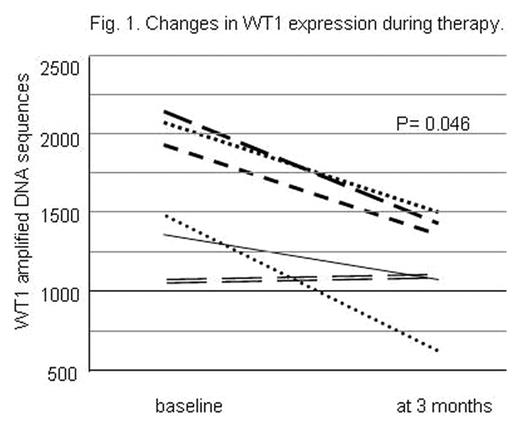Abstract
Background: Gene expression profiles have been associated with prognosis in myelodysplastic syndromes. WT1 is a tumor-suppressor gene coding for a transcription factor located on chromosome 11p13, which was originally identified for its involvement in the pathogenesis of the Wilms’ tumor. In normal bone marrow, WT1 expression is low or undetectable, whereas it is aberrantly expressed in hematological malignancies. Evidence indicates that WT1 is important in the lineage-specific differentiation of hematopoietic cells and leukemogenesis. In myelodysplastic syndromes (MDS), WT1 expression has prognostic significance: it is directly correlated with the type of MDS, with IPSS score and with disease progression. Recent data demonstrate that WT1 is a potent activator of the EPO gene under normoxia and it is suggested that WT1 may regulate paracrine EPO synthesis in a tissue-specific manner. Bmi-1 is a transcriptional repressor gene which may be expressed restrictedly in stem cells and progenitors and is required to regulate the adult self-renewing hematopoietic and leukemic stem cells. It appears that it also plays an important role in providing cells the potential for proliferation. A number of reports on Bmi-1 provide perspectives on the close association of its expression with the progression of hematopoietic malignancies. Furthermore, flow cytometry has shown that Bmi-1 positivity in CD34+ cells is positively correlated with IPSS score.
Introduction: We have designed a study to evaluate changes in gene expression profiles of bone marrow mononuclear cells of primary low and intermediate-1 IPSS risk MDS patients receiving erythropoetic growth factors (darbepoetin or high-dose rHuEpo alpha). Associations with response, changes in Hb, in percentage of CD34+ and apoptotic cells are evaluated. We present preliminary results in 6 patients.
Methods: Bone marrow samples were obtained before and after 12 weeks of treatment. Mononucleated cells were cryopreserved and later thawed for total RNA extraction and cDNA synthesis. Gene expression profiling and the expressions of WT1 and Bmi-1 by RT-PCR were evaluated.
Results: Baseline median Hb was 9,5 g/dL (interquartile range 8,7 10,1). Baseline mean Bmi-1 was 14011 (± SD 3927). All patients had a major erythroid response to treatment. Preliminary results demonstrate a significant decrease in WT1 from baseline median 1635 (interquartile range 1251–2150) to 1192 (interquartile range 1005–1365, P=0.046).
Changes in WT1 expression during therapy.
Discussion: Though few patients have yet been studied, it is suggested that WT1 decreases in patients responding to erythropoetic growth factors. Further evaluation with stratification for erythropoetic response in the extended study may furnish novel associations between gene expression, erythropoetic growth factors and prognosis in MDS patients.
Author notes
Disclosure: No relevant conflicts of interest to declare.


This feature is available to Subscribers Only
Sign In or Create an Account Close Modal